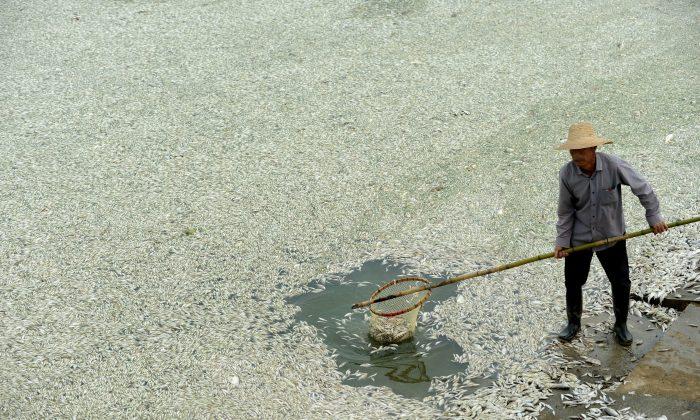On Sept. 2 dead fish began appearing on the Fu River in Wuhan, the capital of central China’s Hubei Province. Soon 25 miles of river were covered with dead and dying fish.
According to a Sept. 4 report by Chinese Radio Network, a staff member at the Wuhan municipal Emergency Office said excessive ammonia at more than 100 times an acceptable level was responsible for the fish die off.
According to the Provincial Environmental Protection Department the ammonia had been discharged over a period of 40 hours by a plant owned by the Hubei Shuanghuan Science and Technology Stock Co. Ltd. The New York Times quoted Ma Jun, director of the nongovernmental Institute of Public and Environmental Affairs, as saying the plant had been cited for environmental violations four times since 2008.
A staff member at the Huangpi District Environmental Protection Bureau told the Hubei-based Chutian Jin Daily, “After testing water quality in the many segments of the river, it’s confirmed that the current situation is worse than Grade IV and V water quality. People and livestock must stay away from it as far as possible.”
Because the Fu River is not used for drinking water, officials said the chemical spill did not affect the region’s drinking water.
The District Environmental Protection Bureau said that the river water has a revolting smell. It warned that hands that come into contact with the water would have a burning sensation for hours.
The Chutian Jin Daily reported that residents of Wuhan first saw the dead fish early in the morning of Sept. 2, and there were also unknown greenish objects floating on the river at the same time. In the afternoon more dead fish appeared downstream on the Fu River.
Many residents along the river started picking up dead fish with sticks and nets. Some fisherman also started purchasing dead fish from the residents.
At 5 p.m., numerous dead fish were found near the Fu River Bridge, among them many were tilapia and topmouth culter fish, about one inch long. Fish that were not completely dead were struggling to breathe out of water, the newspaper said.
Mr. Zhang, a local fisherman told the newspaper that water was turning greenish, water quality was increasingly deteriorating causing a large amount of carp to come to the surface.
“Carp is predominately a bottom fish, with a high tolerance to a variety of water conditions. They are unlikely to float on the surface of the river,” Zhang said.
Some birds died soon after eating dead fish, according to the Wuhan-based Changjiang Daily.
The state-run Xinhua news agency reported that as of the afternoon of Sept. 3 110 tons of dead fish had been cleared from the river.
The die off in the Fu river follows massive fish die offs in Suya Lake in central China’s Henan Province around Aug. 27-28, where fish farmers are reported to have suffered losses in excess of US$1 million, and on Aug. 15 in Xiamen Lake in eastern China.
Translated by John Wang. Written in English by Stephen Gregory.
Read the original Chinese article.





